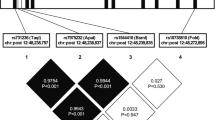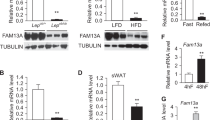Abstract
A previous expression profiling of visceral adipose tissue (VAT) revealed that the immune response gene interferon-gamma-inducible protein 30 (IFI30) gene was 1.72-fold more highly expressed in non-diabetic severely obese men with the metabolic syndrome as compared to those without. Given the importance of low-grade inflammation in obesity-related metabolic complications, we hypothesized that variants in the IFI30 gene are associated with cardiovascular disease (CVD) risk factors. A detailed genetic investigation was performed at the IFI30 locus by sequencing its promoter, exons and intron–exon junction boundaries using DNA of 25 severely obese men. Among the 21 sequence-derived single-nucleotide polymorphisms (SNPs), 5 tagged SNPs (covering 100% of the common SNPs identified) were genotyped in two independent samples of severely obese patients (total n = 1,283). Using a multistage experimental design, chi-square analyses and logistic regressions were performed to compare genotype frequencies and compute odds-ratios (OR) for low and high CVD risk groups (dyslipidemia, hyperglycemia/diabetes and hypertension). A significant association was observed with the non-synonymous SNP rs11554159 (p.R76Q), where GA individuals showed lower risk (OR = 0.67; P = 0.0009) for hyperglycemia/diabetes as compared to homozygotes for the major allele (GG). No association was observed between rs11554159 and VAT IFI30 mRNA levels (P = 0.81), and the expression levels were not correlated with fasting plasma glucose levels (P = 0.31) in 112 non-diabetic severely obese women. The localization of rs11554159 near the active site of IFI30 suggests a functional effect of this SNP. This study showed a novel association between rs11554159 (p.R76Q) polymorphism at the IFI30 locus and the risk of hyperglycemia/diabetes in severely obese individuals.

Similar content being viewed by others
Abbreviations
- BMI:
-
Body mass index
- bp:
-
Base pair
- CRP:
-
C-reactive protein
- CVD:
-
Cardiovascular disease
- GILT:
-
Gamma-interferon-inducible lysosomal thiol reductase
- GLM:
-
General linear model
- HDL:
-
High-density lipoprotein
- IDF:
-
International Diabetes Federation
- IFI30:
-
Interferon-gamma-inducible protein 30
- LD:
-
Linkage disequilibrium
- LDL:
-
Low-density lipoprotein
- LS:
-
Least square
- MAF:
-
Minor allele frequency
- MHC:
-
Major histocompatibility complex
- MS:
-
Metabolic syndrome
- NCEP-ATPIII:
-
National Cholesterol Education Program-Adult Treatment Panel III
- qRT-PCR:
-
Quantitative real-time reverse transcriptase polymerase chain reaction
- OR:
-
Odds-ratio
- SNPs:
-
Single-nucleotide polymorphisms
- T2D:
-
Type 2 diabetes
- TSS:
-
Translation start site
- UTR:
-
Untranslated region
- VAT:
-
Visceral adipose tissue
References
Adzhubei IA, Schmidt S, Peshkin L, Ramensky VE, Gerasimova A, Bork P, Kondrashov AS, Sunyaev SR (2010) A method and server for predicting damaging missense mutations. Nat Methods 7:248–249
Alberti KG, Zimmet P, Shaw J (2006) Metabolic syndrome—a new world-wide definition. A Consensus Statement from the International Diabetes Federation. Diabet Med 23:469–480
Anis AH, Zhang W, Bansback N, Guh DP, Amarsi Z, Birmingham CL (2010) Obesity and overweight in Canada: an updated cost-of-illness study. Obes Rev 11:31–40
Arunachalam B, Phan UT, Geuze HJ, Cresswell P (2000) Enzymatic reduction of disulfide bonds in lysosomes: characterization of a gamma-interferon-inducible lysosomal thiol reductase (GILT). Proc Natl Acad Sci USA 97:745–750
Barrett JC, Fry B, Maller J, Daly MJ (2005) Haploview: analysis and visualization of LD and haplotype maps. Bioinformatics 21:263–265
Bluher M (2010) The distinction of metabolically ‘healthy’ from ‘unhealthy’ obese individuals. Curr Opin Lipidol 21:38–43
Bouchard L, Tchernof A, Deshaies Y, Marceau S, Lescelleur O, Biron S, Vohl MC (2007) ZFP36: a promising candidate gene for obesity-related metabolic complications identified by converging genomics. Obes Surg 17:372–382
Bouchard L, Faucher G, Tchernof A, Deshaies Y, Lebel S, Hould FS, Marceau P, Vohl MC (2009a) Comprehensive genetic analysis of the dipeptidyl peptidase-4 gene and cardiovascular disease risk factors in obese individuals. Acta Diabetol 46:13–21
Bouchard L, Faucher G, Tchernof A, Deshaies Y, Marceau S, Lescelleur O, Biron S, Bouchard C, Perusse L, Vohl MC (2009b) Association of OSBPL11 gene polymorphisms with cardiovascular disease risk factors in obesity. Obesity (Silver Spring) 17(7):1466–1472. doi:10.1038/oby.2009.71
Cameron AJ, Dunstan DW, Owen N, Zimmet PZ, Barr EL, Tonkin AM, Magliano DJ, Murray SG, Welborn TA, Shaw JE (2009) Health and mortality consequences of abdominal obesity: evidence from the AusDiab study. Med J Aust 191:202–208
Collins DS, Unanue ER, Harding CV (1991) Reduction of disulfide bonds within lysosomes is a key step in antigen processing. J Immunol 147:4054–4059
Expert Panel on Detection EaToHBCiA (2001) Executive summary of the third report of the national cholesterol education program (NCEP) expert panel on detection, evaluation, and treatment of high blood cholesterol in adults (Adult Treatment Panel III). JAMA 285:2486–2497
Hajer GR, van Haeften TW, Visseren FL (2008) Adipose tissue dysfunction in obesity, diabetes, and vascular diseases. Eur Heart J 29:2959–2971
Hastings KT, Cresswell P (2011) Disulfide reduction in the endocytic pathway: immunological functions of gamma-interferon-inducible lysosomal thiol reductase. Antioxid Redox Signal. doi:10.1089/ars.2010.3684
Karelis AD, St Pierre DH, Conus F, Rabasa-Lhoret R, Poehlman ET (2004) Metabolic and body composition factors in subgroups of obesity: what do we know? J Clin Endocrinol Metab 89:2569–2575
Konig IR, Ziegler A (2003) Group sequential study designs in genetic-epidemiological case–control studies. Hum Hered 56:63–72
Lahiry P, Pollex RL, Hegele RA (2008) Uncloaking the genetic determinants of metabolic syndrome. J Nutrigenet Nutrigenomics 1:118–125
Lindholm E, Melander O, Almgren P, Berglund G, Agardh CD, Groop L, Orho-Melander M (2006) Polymorphism in the MHC2TA gene is associated with features of the metabolic syndrome and cardiovascular mortality. PLoS One 1:e64
Livak KJ, Schmittgen TD (2001) Analysis of relative gene expression data using real-time quantitative PCR and the 2(-Delta Delta C(T)) Method. Methods 25:402–408
Marceau P, Hould FS, Simard S, Lebel S, Bourque RA, Potvin M, Biron S (1998) Biliopancreatic diversion with duodenal switch. World J Surg 22:947–954
Maric M, Arunachalam B, Phan UT, Dong C, Garrett WS, Cannon KS, Alfonso C, Karlsson L, Flavell RA, Cresswell P (2001) Defective antigen processing in GILT-free mice. Science 294:1361–1365
Martinez A, Sanchez-Lopez M, Varade J, Mas A, Martin MC, de Las Heras V, Arroyo R, Mendoza JL, Diaz-Rubio M, Fernandez-Gutierrez B, de la Concha EG, Urcelay E (2007) Role of the MHC2TA gene in autoimmune diseases. Ann Rheum Dis 66:325–329
Mathieu P, Poirier P, Pibarot P, Lemieux I, Despres JP (2009) Visceral obesity: the link among inflammation, hypertension, and cardiovascular disease. Hypertension 53:577–584
Mathieu P, Lemieux I, Despres JP (2010) Obesity, inflammation, and cardiovascular risk. Clin Pharmacol Ther 87:407–416
Singh R, Cresswell P (2010) Defective cross-presentation of viral antigens in GILT-free mice. Science 328:1394–1398
Sobell JL, Heston LL, Sommer SS (1993) Novel association approach for determining the genetic predisposition to schizophrenia: case–control resource and testing of a candidate gene. Am J Med Genet 48:28–35
Teran-Garcia M, Bouchard C (2007) Genetics of the metabolic syndrome. Appl Physiol Nutr Metab 32:89–114
The Expert Committee on the Diagnosis and Classification of Diabetes Mellitus (2003) Report of the expert committee on the diagnosis and classification of diabetes mellitus. Diabetes Care 26(Suppl 1):S5–S20
Vohl MC, Sladek R, Robitaille J, Gurd S, Marceau P, Richard D, Hudson TJ, Tchernof A (2004) A survey of genes differentially expressed in subcutaneous and visceral adipose tissue in men. Obes Res 12:1217–1222
Vohl MC, Houde A, Lebel S, Hould FS, Marceau P (2005) Effects of the peroxisome proliferator-activated receptor-gamma co-activator-1 Gly482Ser variant on features of the metabolic syndrome. Mol Genet Metab 86:300–306
WHO (2000) Obesity: preventing and managing the global epidemic. Report of a WHO consultation. World Health Organ Tech Rep Ser 894:i–xii, 1–253
Winer DA, Winer S, Shen L, Wadia PP, Yantha J, Paltser G, Tsui H, Wu P, Davidson MG, Alonso MN, Leong HX, Glassford A, Caimol M, Kenkel JA, Tedder TF, McLaughlin T, Miklos DB, Dosch HM, Engleman EG (2011) B cells promote insulin resistance through modulation of T cells and production of pathogenic IgG antibodies. Nat Med 17:610–617
Acknowledgments
This study was supported by a grant from the Canadian Institutes of Health Research (CIHR: MOP-200609). The severely obese cohort was supported, over the years, by the Laval University Merck-Frosst/CIHR Research Chair in Obesity. We express our gratitude to surgeons Simon Marceau, Simon Biron, Odette Lescelleur and Laurent Berthio of the Quebec Heart and Lung Institute who have sampled adipose tissues for this project. Many thanks are also expressed to Fanny Therrien and Caroline Nadeau for their help in adipose tissue banking management. Valérie Turcot received studentship awards from the Canadian Institutes of Health Research and the Fonds de la Recherche en Santé du Québec. André Tchernof is a research scholar from the Fonds de la Recherche en Santé du Québec. Marie-Claude Vohl is Tier 1 Canada Research Chair in Genomics Applied to Nutrition and Health.
Conflict of interest
The authors declare that they have no conflict of interest.
Author information
Authors and Affiliations
Corresponding author
Rights and permissions
About this article
Cite this article
Turcot, V., Bouchard, L., Faucher, G. et al. A polymorphism of the interferon-gamma-inducible protein 30 gene is associated with hyperglycemia in severely obese individuals. Hum Genet 131, 57–66 (2012). https://doi.org/10.1007/s00439-011-1043-4
Received:
Accepted:
Published:
Issue Date:
DOI: https://doi.org/10.1007/s00439-011-1043-4




